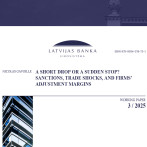No economic growth at the beginning of 2016 either
In accordance with the flash estimate of the Central Statistical Bureau (CSB), gross domestic product (GDP) at constant prices fell by 0.1% in the first quarter of 2016 compared with the fourth quarter of 2015, while a 1.3% year-on-year increase was recorded according to calendar adjusted data. It is important to take into account that there were 29 days in February this year; therefore, annual changes consistent with unadjusted data are more pronounced (1.8%). These data confirm concerns expressed earlier that GDP growth could be slower this year than in previous years.
At the beginning of the year, manufacturing posted relatively weak results, except energy, while retail trade grew moderately. Although preliminary data of the transport sector, i.e. the volume of cargoes loaded and unloaded at ports and the volume of rail freight, suggest that the situation will continue to deteriorate, the sector as a whole reports growth apparently due to the contribution by road transport.
This time the major factor holding back GDP growth is a considerably smaller volume of construction works (–22%). One cannot say that this comes as a great surprise since, first, this year, especially the first half of the year, will see the projected slowdown due to the disruption of the European Union (EU) funding cycle. Second, winter this year was slightly colder year-on-year. The average temperature this year reached –1.9°C, but last year it stood at +0.8°C [1].
This, possibly, also affected external construction works.
What do the current data mean? They confirm that GDP could grow slower this year than in previous years. Several factors hindering GDP growth must be mentioned. First, growth projections of Latvia's partners continue to be revised mainly downwards. However it should be recognised that the recent data on GDP growth in the euro area in the first quarter of 2016 have exceeded forecasts, i.e. according to seasonally adjusted data, the euro area economy has grown by 0.6% quarter-on-quarter and by 1.6% year-on-year.
Second, the situation on the global commodity markets currently has adverse effects on Latvia. The low prices of various commodities, i.e. metals, food and coal, have led to problems in individual manufacturing subsectors (manufacture of basic metals, food industry), as well as in the transport sector. Although the low oil prices have had a positive impact on consumption so far, their effect is decreasing due to the saturation effect (nobody drives his car more than necessary even if fuel costs less). Moreover, recent trends indicate that oil prices are gradually rising. This means that the positive effect on consumption is declining (currently Brent oil price is hovering around 48 US dollars per barrel; this peak was last reached at the beginning of November 2015). However, oil prices affect external demand of Latvia's important trade partners Russia and also Norway.
Finally, the disruption of the EU funding cycle the domestic economy faced at the beginning of the year significantly hampered the construction activity.
In the absence of new substantial shocks GDP will likely grow faster in the second half of the year and also in 2017. This is evident from both the current forecast on growth of the external trade partners and the plan of the EU funding cycle. Consequently, the slowdown of Latvia's economic growth is of a short-term nature. Latvijas Banka's GDP growth forecast for this year is 2.3%. The current data do not require its revision yet. Detailed GDP data will be published on 31 May 2016. They will contain information on sectoral development, as well as GDP expenditure and income aspects.
Textual error
«… …»






